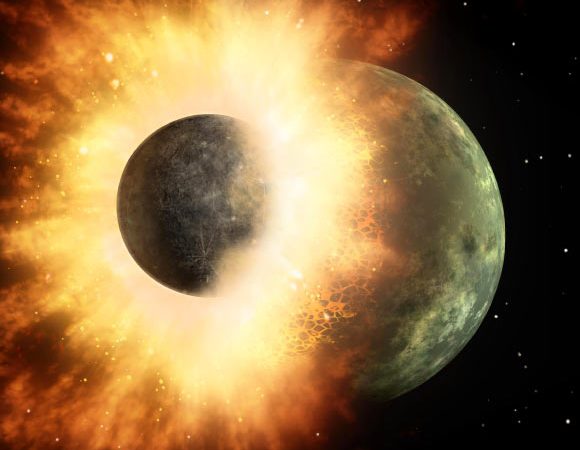Planetary researchers believe that our Moon was created more than 4.4 billion years ago in a catastrophic collision between proto-Earth and a hypothetical planet-sized body known as Theia. According to new research, our planet received the bulk of its carbon, nitrogen, sulfur and other life-essential elements from that planetary collision.
“From the study of primitive meteorites, scientists have long known that Earth and other rocky planets in the inner Solar System are volatile-depleted,” said Rice University researcher Rajdeep Dasgupta, co-lead author of the study.
“But the timing and mechanism of volatile delivery has been hotly debated. Ours is the first scenario that can explain the timing and delivery in a way that is consistent with all of the geochemical evidence.”
In a series of experiments, Dr. Dasgupta and co-authors gathered evidence to test a theory that Earth’s volatiles arrived from a collision with an embryonic planet that had a sulfur-rich core.
The sulfur content of the donor planet’s core matters because of the puzzling array of experimental evidence about the carbon, nitrogen and sulfur that exist in all parts of the Earth other than the core.
“The core doesn’t interact with the rest of Earth, but everything above it, the mantle, the crust, the hydrosphere and the atmosphere, are all connected. Material cycles between them,” said co-lead author Damanveer Grewal, a graduate student at Rice University.
One long-standing idea about how our planet received its volatiles was the ‘late veneer’ theory that volatile-rich meteorites arrived after Earth’s core formed.
And while the isotopic signatures of Earth’s volatiles match these primordial objects, known as carbonaceous chondrites, the elemental ratio of carbon to nitrogen is off.
Earth’s non-core material, which geologists call the bulk silicate Earth, has about 40 parts carbon to each part nitrogen, approximately twice the 20-1 ratio seen in carbonaceous chondrites.
The team’s experiments, which simulated the high pressures and temperatures during core formation, tested the idea that a sulfur-rich planetary core might exclude carbon or nitrogen, or both, leaving much larger fractions of those elements in the bulk silicate as compared to Earth.

In a series of tests at a range of temperatures and pressure, the scientists examined how much carbon and nitrogen made it into the core in three scenarios: no sulfur, 10% sulfur and 25% sulfur.
“Nitrogen was largely unaffected. It remained soluble in the alloys relative to silicates, and only began to be excluded from the core under the highest sulfur concentration,” Grewal said.
Carbon, by contrast, was considerably less soluble in alloys with intermediate sulfur concentrations, and sulfur-rich alloys took up about 10 times less carbon by weight than sulfur-free alloys.
Using this information, along with the known ratios and concentrations of elements both on Earth and in non-terrestrial bodies, the team designed a computer simulation to find the most likely scenario that produced Earth’s volatiles.
“What we found is that all the evidence — isotopic signatures, the carbon-nitrogen ratio and the overall amounts of carbon, nitrogen and sulfur in the bulk silicate Earth — are consistent with a Moon-forming impact involving a volatile-bearing, Mars-sized planet with a sulfur-rich core,” Grewal said.
The findings were published online this week in the journal Science Advances.
Source: Sci News

































Leave a Comment
You must be logged in to post a comment.